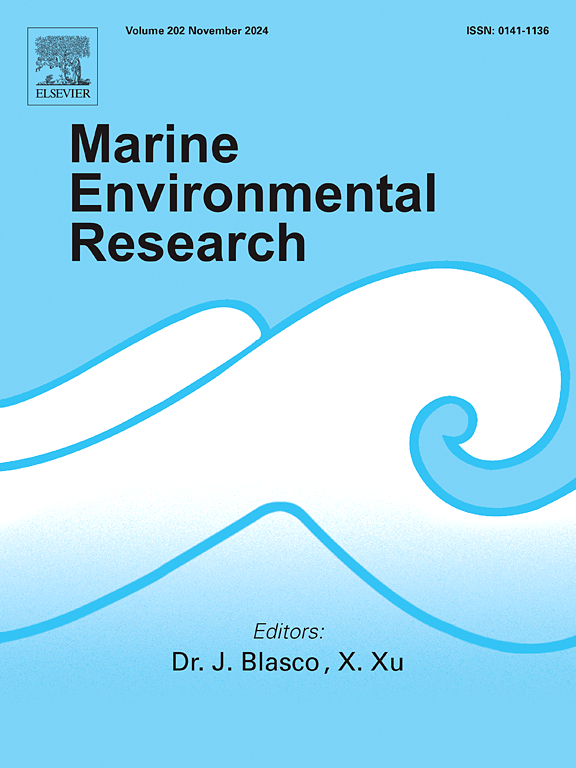Regulation of the colloidal organic matter in coastal waters by scallop farming
IF 3
3区 环境科学与生态学
Q2 ENVIRONMENTAL SCIENCES
引用次数: 0
Abstract
To investigate the influence of scallop farming on the biogeochemical characteristics of colloidal organic matter (COM, 1 kDa-0.7 μm), surface and bottom seawater samples collected from a bay scallop mariculture area (MA) and its adjacent waters were size-fractionated and analyzed for absorption and fluorescence characteristics. Compared to inshore shallow water area and non-mariculture area (NMA), COM in MA exhibited the highest proportion of a350 in bulk dissolved organic matter, while the contribution of its 100 kDa-0.7 μm high molecular weight fraction (HCOM) was the lowest. Protein-like components, including tryptophan-like C1 and tyrosine-like C2, predominated in the fluorescent substances of HCOM; while humic-like components, including microbial humic-like C3 and terrestrial humic-like C4, dominated in the fluorescent substances of 1-3 kDa low molecular weight fraction of COM (LCOM). COM transformation was influenced by scallop farming via selective filter-feeding and enhanced degradation of microorganisms. Compared with NMA, phytoplankton production mainly affected the a350 and protein-like substances of HCOM in the surface seawater of MA, and its contributions increased by 2.4% (a350), 5.6% (C1), and 1.8% (C2) respectively. Meanwhile, microbial degradation significantly influenced component C1 of HCOM in the bottom seawater of MA, reducing its contribution by 33.2%; its impact on the contributions of humic-like fluorescent substances of LCOM were decreased by 2.7% for C3 and 1.1% for C4. These variations suggest that scallop farming promotes the production and transformation of protein-like substances in HCOM (mainly C1), potentially leading to an accumulation of humic-like substances in LCOM due to altered microbial degradation dynamics. Photodegradation, particulate organic matter settling, sediment release and colloidal aggregation/disaggregation also influence the transformation of size-fractionated COM.

求助全文
约1分钟内获得全文
求助全文
来源期刊

Marine environmental research
环境科学-毒理学
CiteScore
5.90
自引率
3.00%
发文量
217
审稿时长
46 days
期刊介绍:
Marine Environmental Research publishes original research papers on chemical, physical, and biological interactions in the oceans and coastal waters. The journal serves as a forum for new information on biology, chemistry, and toxicology and syntheses that advance understanding of marine environmental processes.
Submission of multidisciplinary studies is encouraged. Studies that utilize experimental approaches to clarify the roles of anthropogenic and natural causes of changes in marine ecosystems are especially welcome, as are those studies that represent new developments of a theoretical or conceptual aspect of marine science. All papers published in this journal are reviewed by qualified peers prior to acceptance and publication. Examples of topics considered to be appropriate for the journal include, but are not limited to, the following:
– The extent, persistence, and consequences of change and the recovery from such change in natural marine systems
– The biochemical, physiological, and ecological consequences of contaminants to marine organisms and ecosystems
– The biogeochemistry of naturally occurring and anthropogenic substances
– Models that describe and predict the above processes
– Monitoring studies, to the extent that their results provide new information on functional processes
– Methodological papers describing improved quantitative techniques for the marine sciences.
 求助内容:
求助内容: 应助结果提醒方式:
应助结果提醒方式:


